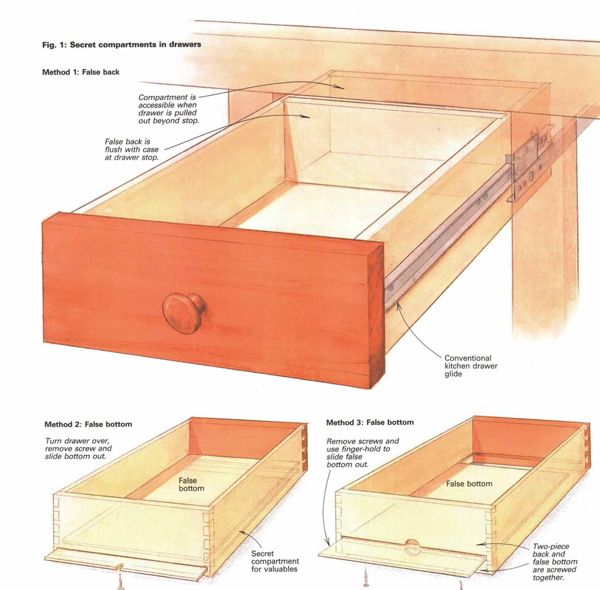
Synopsis: Chris Becksvoort says secret compartments were so common before safety-deposit boxes that they could be considered a hallmark of custom-built furniture. They allow furnituremakers leeway in placement, size, and construction. Becksvoort explains how to hide compartments in drawers, desks, hollow posts, tables, and the tops and bottoms of cabinets. Side information covers hiding spaces in built-ins.
Secret compartments were so common in the days before safety-deposit boxes that they could be considered a hallmark of custom-built furniture. And, because hidden compartments have been popular among the well-to-do since ancient times, craftsmen have had plenty of time to come up with all sorts of hiding places. They can be a simple drawer fit into otherwise wasted space inside a cabinet or complex and imaginative devices based on hollow members, springs, catches and sliding panels—anything to fool the eye. Secret compartments are often commissioned for a specific purpose, such as hiding coins, jewelry, precious documents or pictures; sometimes they are the furnituremaker’s whimsical secret, unbeknownst to the customer until the piece is delivered.
These surprise compartments are my favorites. They allow me the most leeway in placement, size and construction; in addition, the customer feels like the recipient of a gift—an unexpected bonus. It also seems only right that a hidden compartment should be a secret shared only by the furnituremaker and the furniture’s owner. Let’s face it, a hidden compartment advertised in The New Yorker is no secret by anyone’s standards, but merely a sales gimmick.
Some types of furniture lend themselves better to hidden compartments than others. The best are case pieces with drawers and desks with pigeonholes, But tables, beds, clocks and even lamps can be adapted to contain these intriguing tricks of the trade. I’ll describe some of those I’ve used in my own work or seen in other pieces of furniture. These examples are only a few of the possibilities: There are many others, from the extremely simple to the clever and complicated. The next time you’re designing a piece, take a little extra time to examine how you can utilize any wasted space in the furniture. You’ll be amazed at how thrilled your customers will be.
Drawers—Years ago while working on a kitchen, it occurred to me that most drawer glides, except the full-extension models, leave the back 4 in. of the drawer essentially inaccessible. So I ran a cross-grain dado in. from the back end on each drawer side and inserted a side-to-side divider. When the drawer is pulled out to the stop, as shown in method 1 on the facing page, the false back is flush with the case. When the glide stops are released, the drawer can be pulled out to access the long narrow compartment beyond the false back.
From Fine Woodworking #74
For the full article, download the PDF below:
Fine Woodworking Recommended Products

Estwing Dead-Blow Mallet

Bessey K-Body Parallel-Jaw Clamp

Starrett 12-in. combination square























Log in or create an account to post a comment.
Sign up Log in